There are certain things I look to as indicators of a game’s overall quality without having to, you know, play the entire thing end to end. One thing that has been a semi-reliable indicator is the sound track which, for the most part, usually feels like an afterthought for most games. For those where it’s front and center, and even better put together by a composer I’ve loved for many years, then there’s a good chance that the rest of the game is probably worth looking into. This is how I came to find myself wanting to play Immortals: Fenyx Rising as its opening theme got recommended to me in Spotify. Little did I know at the time that this was actually a game I was already interested in, just no longer under its old name of Gods and Monsters. This is perhaps one of the few games I’ve played recently where the first 4 hours or so had me really not liking the experience but seemingly, after then, coming around to it and enjoying it for what it is.
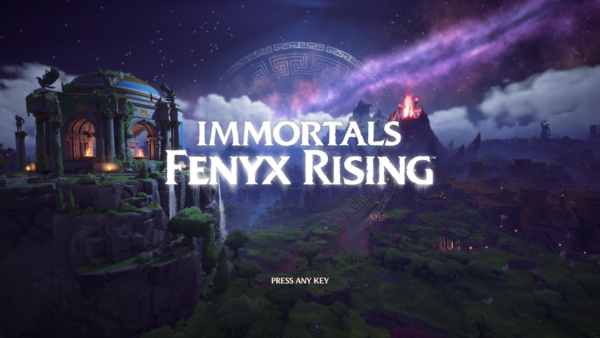
After spending eons imprisoned under a mountain by Zeus, Typhon manages to escape and takes his revenge on the Olympian gods, severing them from their godly essences and robbing them of their powers. Zeus flees and meets Prometheus, seeking to secure his aid in battling Typhon. Prometheus instead makes a wager with Zeus that if Typhon can be beaten by a mortal, then he will be freed from his imprisonment. Otherwise, Prometheus will agree to help Zeus. Prometheus then uses his power of foresight to tell the story of Fenyx. This is where your story begins, shipwrecked on the island of the gods with an insurmountable battle ahead of you.
Now if the title of this post didn’t make it obvious enough the numerous references I’m going to make to Breath of the Wild in the rest of the post will. The game clearly takes heavy inspiration from the last Zelda game in many respects, starting first off with the art style. Whilst it is a more modern implementation of the heavy stylization that newer Zelda games are known for it is still very much in the same vein. This initially belies the amount of detail that’s been put into the game as it was quickly able to bring my (admittedly old) PC rig to its knees with the default settings. Optimising these settings got rid of the performance issues in most places but did come at the price of reducing the eye candy. With this in mind it’s definitely a game I’d recommend for more up to date PCs or current gen consoles as it can be quite a lovely visual experience when it wants to be.
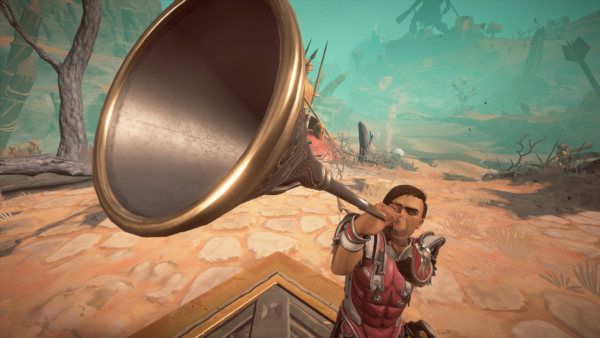
This is an Ubisoft game so you pretty much know what you’re in for up front. It’s the typical open world sandbox game with a bunch of side quests, crafting and other bits thrown in to keep you entertained for hours on end. There’s loot to hunt down, rare mounts to collect and various different aspects of your character to upgrade that’ll certainly take an inordinate amount of time to max out if you’re so inclined. However, past a certain point, most of these things become largely irrelevant, most of them being convenience/quality of life things or upgrades in the barest sense of the world. Realistically at a certain point in the game you’re going to figure out what works for you and min/max around that. It’s at that point that the game turned from yet another grind fest to an actual enjoyable experience for me as I felt I was able to exploit the game’s various foibles to my advantage.
Combat follows the BOTW trope of a souls-like experience that’s a little more forgiving due to the inclusion of all the random powers, interactions and other nuances of the game that make fights easier. To begin with most fights are a bit of a slog, requiring you to do the usual dodge/hit/dodge routine for far too long on even basic enemies. Over time though, as you get more upgrades and abilities, you’ll be able to craft a much more interesting combat loop for yourself. If you’re like me you’ll quickly notice that maximizing stun on your abilities and damage on your sword makes you rather unstoppable, especially when using Ares’ Wrath to AOE stun basically everything but the biggest enemies immediately which then leaves you free to clean up as you please. There are even more broken combos to exploit if you’re keen, like using Phosphor to freeze your enemies, Ares Wrath-ing them, and repeating that to effecting stun lock any enemy.
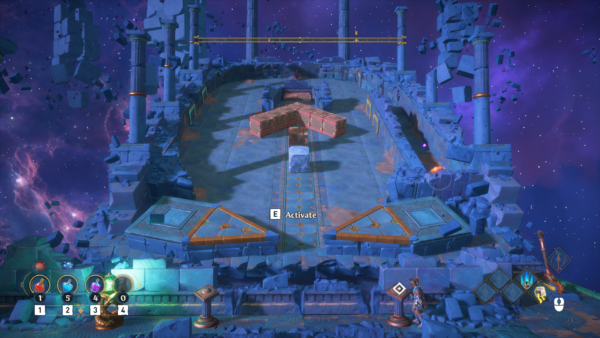
As you’d expect from an Ubisoft game there’s numerous progression systems and collectibles to hunt down, most of which come in the form of puzzles, dungeons and time trials that are scattered around the map. I had a preference for a few kinds of puzzles, mostly the ones that didn’t require me to do several mini-puzzles in order to do the big one. The dungeons are probably the most tedious ones of the lot, given that they take the longest and honestly don’t give the biggest reward for the time invested. Compare that to other upgrades like the coins for your abilities or the ambrosia for your health, both of which can be gathered pretty quickly if you need them, and I really didn’t end up seeking out many dungeons to get my stamina upgraded. Not that I really needed it though given that the blue mushrooms (which restore stamina) are basically falling into your pockets as you play the game, ensuring you’ve got essentially unlimited stamina anyway.
Armour and weapons are mostly focused on augmenting certain abilities and play styles rather than being focused on raw stats. Instead all swords and armour share the same values which you’re able to upgrade at the forge. I kind of like this system as it means there’s less focus on flooding you with tons of useless loot to sift through and you can focus more directly on getting the items you need to fit the way you want to play. This does also mean however that you’re probably not likely to explore too far beyond your comfort zone once you get there. For instance I settled pretty early on a robe that restored health on hit (because why would you wear anything else) and a helm that increased the damage and stun of Ares’ wrath. Similarly I used the same sword for most of the game and just chose whatever bow and axe looked cool since they barely got any use. Is this a bad thing? I don’t think so and being able to hone my build to my liking is one of the reasons I kept playing beyond my initial distaste for the game.
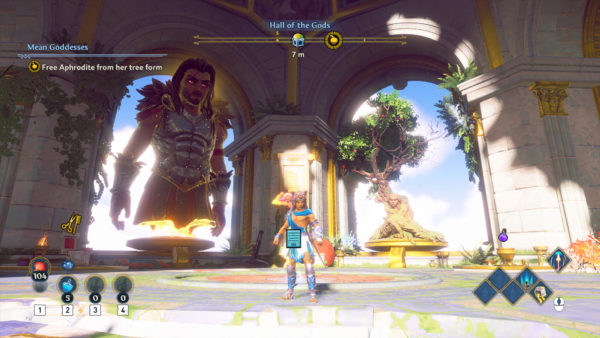
Crafting is limited to potions, of which there are only 4: health, defense, attack and stamina. These are also upgradeable with yet another in-game currency that you’ll get from…some activity in the game. For the health and stamina potion upgrades they just increase their effectiveness directly, but for the attack and defense ones you can actually unlock some really good additional bonuses when you use them. I’ll admit that I didn’t really use them for much of the game but the last few hours, when I was up against bosses with stupidly large health pools and large AOE attacks that are pretty hard to avoid, they made the experience actually fun rather than a slogfest of dodging and rolling.
Getting around the island at the start is a real chore, mostly because you don’t have enough stamina to glide very far and the initial mounts are pretty useless. However this is pretty easily remedied by getting a few key upgrades with Coins of Charon and tracking down one of the early game epic mounts which are literally just there for you to tame without any other requirements. Indeed one of them is a short walk south of the Hall of the Gods, meaning that it won’t take much to make travelling around the island that much better. Honestly if I knew that starting out I think I would’ve had a much better time in the early hours of the game as running around everywhere gets boring quick.
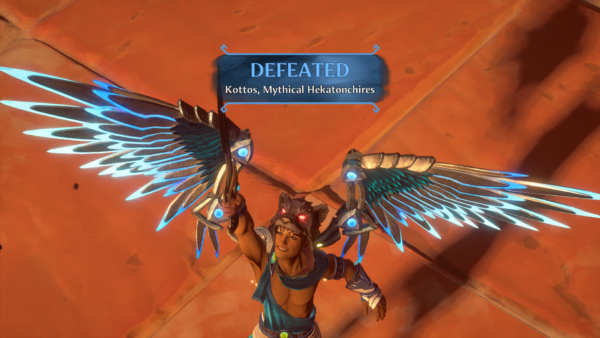
The game still has a few rough edges that could do with some polish, most notably in the interactions between your character and the walls around him. It doesn’t take much for Fenyx to latch onto whatever wall is nearby, which can be rather frustrating when you’re trying to position something. This is more a symptom of the underlying physics engine which, whilst perfectly fine for most instances, is used with reckless abandon for all the puzzles. This means that you’re often relying on some wacky physics interaction to ensure that you complete the puzzle correctly. I can’t tell you how frustrating it is to have to setup something correctly only for the physics interactions to not go your way, forcing you to redo a puzzle all over again. This is also not to mention the interactions with gliding and wind gusts which are supposed to lock you into their path but will often…not for no discernable reason. I have come to expect this kind of jankiness from open world games but that doesn’t mean it’s something I’m going to forgive, especially when I’m coming to this game months after its initial release.
I’ll be honest and say that I’m a little burnt out on the old Greek mythology at the moment. Whilst the retelling of the various myths in this game are a bit of fun, especially with the comedic flair given to the god’s interactions with you, I’ve kind of had my fill of it from the numerous other releases that have used this mythology as a base. I’m not sure what was in the water a few years ago but it seems that everyone figured mining the old Greek gods mythology was going to be the next hot thing and then we’ve ended up with multiple games, TV shows and other forms of media all deriving their main plot lines from it. But hey if you enjoy it then no harm no foul, I’m not going to begrudge someone for enjoying something I’m a little tired of.
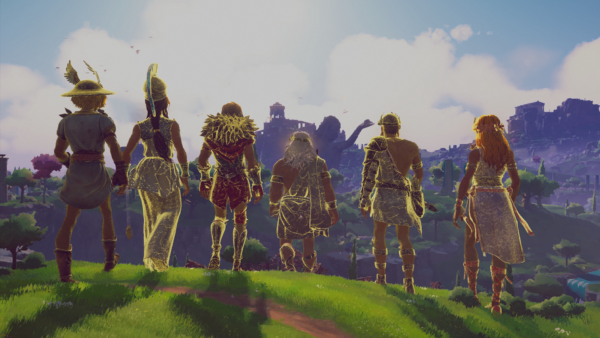
Immortals: Fenyx Rising is one of the few games that has managed to shift my opinion of it for the better the more I played it. To be sure this is your typical Ubisoft affair, one that borrows heavily from a title that’s arguably much better in almost every respect. However that doesn’t mean that the experience it provides isn’t enjoyable, indeed after figuring I’d give up on it after 4 hours or so I found myself closing out the last campaign mission 14 hours later, actually enjoying the process of min/maxing my character and one-shotting nearly any boss I came across. It may be the poor man’s version of Breath of the Wild but it does a pretty job of paying homage to it whilst still trying to differentiate itself from the usual open world dreck that Ubisoft is known for.
Rating: 8.5/10
Immortals: Fenyx Rising is available on PC, PlayStation 4, PlayStation 5, Xbox One, Xbox Series X/S and Nintendo Switch right now for $58. Total play time was 18 hours with 36% of the challenges completed.



